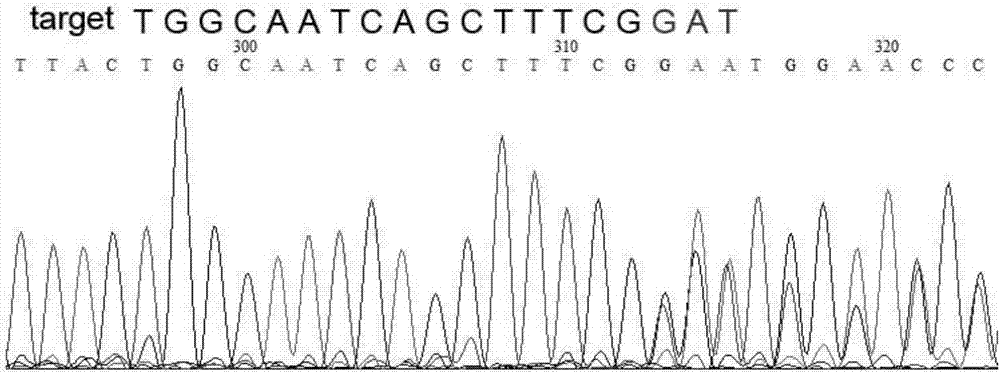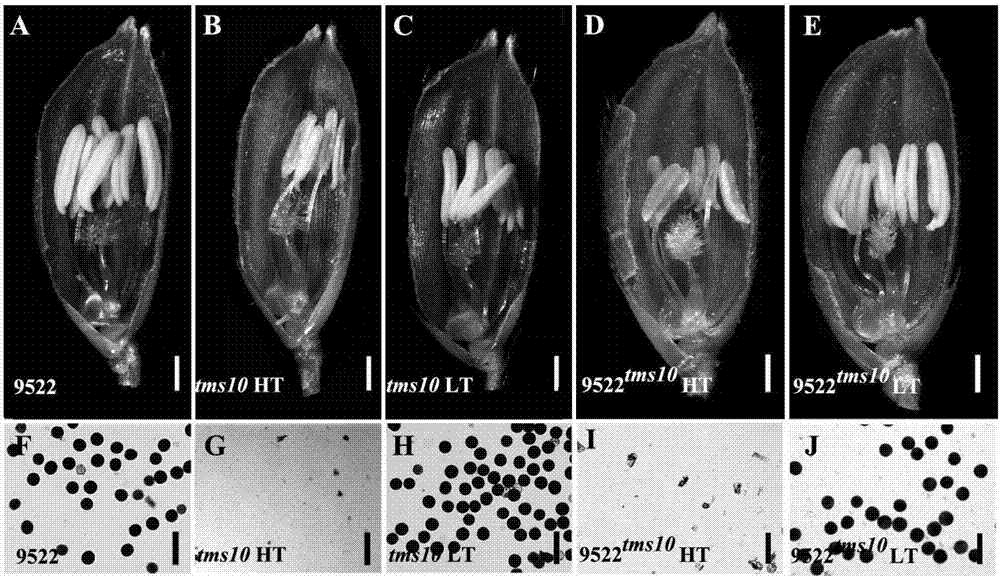Site-directed knockout system for rice TMS10 gene, and applications thereof
A site-directed knockout, rice technology, applied in applications, genetic engineering, introduction of foreign genetic material using vectors, etc., can solve the problems of complex process, high labor cost, and long transfer cycle.
- Summary
- Abstract
- Description
- Claims
- Application Information
AI Technical Summary
Problems solved by technology
Method used
Image
Examples
Embodiment 1
[0036] Example 1, the sequence and analysis of the rice male sterility gene TMS10
[0037] The sequence of the rice male sterility gene TMS10 is shown in SEQ ID NO.1. Sequence analysis shows that the gene includes 11 exons in total, which are respectively the 235th-307th (first exon), the 2241-2373rd (second exon), the 2nd 2487-2558 (third exon), 3271-3414 (fourth exon), 3514-3585 (fifth exon), 3694-3759 (sixth exon) , 3846-3916 (the seventh exon), 4039-4179 (the eighth exon), 4590-4931 (the ninth exon), 5235-5626 (the tenth exon) sub), 5724-6038 (the eleventh exon).
[0038] The present invention uses the 2281st to 2299th nucleotide sequence on the second exon as the target sequence of the CRISPR / Cas9 system.
Embodiment 2
[0039] Example 2, CRISPR / Cas9 system primer design and construction of recombinant expression vector
[0040] 2.1 Selection of CRISPR / Cas9 system target sequence
[0041] The CRISPR / Cas9 system targets the positive-sense strand of the second exon of the rice TMS10 gene, and the target sequence is as follows: 5'-TGGCAATCAGCTTTCGGAT-3' (2281 to 2299 of the sequence of SEQ ID NO.1.
[0042] 2.2 Design and synthesis of target sequence primers for CRISPR / Cas9 system
[0043] Target sequence primers targeting the TMS10 gene were designed based on the CH-CRISPR / Cas9 system. The target sequence primers were as follows: Forward primer: 5'-TGGCGTGGCAATCAGCTTTCGGAT-3' (sequence shown in SEQ ID NO.2, CC-TMS10-1F) and Reverse primer: 5'-AAACATCCGAAAGCTGATTGCCAC-3' (sequence shown in SEQ ID NO.3, CC-TMS10-1R); synthesize the target sequence primer of the CRISPR / Cas9 system.
[0044] 2.3 Construction of CRISPR / Cas9 system recombinant expression vector
[0045] The sequence shown in SEQ ...
Embodiment 3
[0047] Example 3, Activity Detection of Recombinant Expression Vectors
[0048] The recombinant expression vector CC-TMS10-1 in Example 2 was introduced into rice protoplasts through PEG mediation to obtain the transient expression result of the recombinant expression vector CC-TMS10-1; after sequencing verification, the recombinant expression vector CC-TMS10-1 was obtained Peak map of site-directed mutation induced in rice protoplasts ( figure 1 ).
PUM
 Login to View More
Login to View More Abstract
Description
Claims
Application Information
 Login to View More
Login to View More - R&D
- Intellectual Property
- Life Sciences
- Materials
- Tech Scout
- Unparalleled Data Quality
- Higher Quality Content
- 60% Fewer Hallucinations
Browse by: Latest US Patents, China's latest patents, Technical Efficacy Thesaurus, Application Domain, Technology Topic, Popular Technical Reports.
© 2025 PatSnap. All rights reserved.Legal|Privacy policy|Modern Slavery Act Transparency Statement|Sitemap|About US| Contact US: help@patsnap.com



